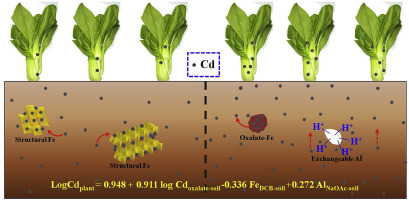Environmental Pollution ( IF 7.6 ) Pub Date : 2017-11-01 , DOI: 10.1016/j.envpol.2017.08.092 Chengshuai Liu , Chunying Chang , Yingheng Fei , Fangbai Li , Qi Wang , Guangshu Zhai , Jing Lei

|
Although many previous studies have reported the soil pH and organic matter to be the most critical factors that affect the transfer of Cd in soil-crop systems in temperate zones, the behavior of Cd transfer is different in the Pearl River Delta (PRD), which is located in a subtropical zone with different climate and soil conditions. Therefore, we must determine the critical environmental factors that influence the transfer of Cd in the soil-vegetable system in the PRD region. Such knowledge can improve the safety of vegetables. In this study, the soil geochemical properties are investigated to explore the key soil factors that control the uptake of Cd by flowering cabbage, a popular leaf vegetable in China, from soils in the PRD region. The Cd contents in vegetables were most positively correlated to soil oxalate-Cd (p < 0.01), which indicates that amorphous Cd is the most available form for uptake into the cabbages. With the characteristics of rich in Fe oxide and Al oxide in the PRD soils, soil Fe and Al oxides were found to be the most relevant to the transfer factors of Cd from the soils to the cabbages. Soil secondary minerals are the key factor that affects the transfer of Cd, thereby influencing the migration and fate of Cd in soil-cabbage systems, with DCB-Fe significantly decreasing the Cd accumulation in cabbages. Additionally, models were developed to predict the enrichment of Cd in flowering cabbages, in which oxalate-Cd, DCB-Fe, and NaOAc-Al in soils were determined to be the most important factors that affect the Cd enrichment in flowering cabbages. In this study, we determine the important role of soil secondary minerals in affecting the transfer of Cd in soil-cabbage systems in the PRD. These observations are important to evaluate the accumulation of Cd in vegetables in subtropical zones.































 京公网安备 11010802027423号
京公网安备 11010802027423号